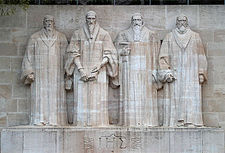
Republication is form of Christian covenant theology where the works principle of the covenant of works was republished in some way in the Mosaic covenant.[2][3] The view is popular among academics of the Westminster Seminary California and was popularized by American theologian Meredith Kline. Kline taught that the Mosaic covenant included a typological republication of the covenant of works, where the Israelites had to maintain possession of the promised land by their "typological merit".[3][4] Republication is similar to the Lutheran views of the Mosaic covenant.[5]
History
[edit]Some aspects of Republication were already taught by John Calvin, but not the view in its entirety.[6] Later, Republication was taught by John Owen, believing that though the Mosaic covenant was a covenant of grace it included a layer of aspects republished from the covenant of works. Thomas Goodwin used similar language to Owen when describing the mosaic covenant.[7] Edward Fisher, the author of the Marrow of Modern Divinity taught republication, saying " therefore, "the law entered," that Adam's offence and their own actual transgression might abound, so that now the Lord saw it needful, that there should be a new edition and publication of the covenant of works", thus the view was advocated by Thomas Boston, who was one of the Marrow divines.[8][9]
Meredith Kline in more recent times has become the most influential advocate of the republication theory.[10]
Other advocates of different forms of republication include: Geerhardus Vos, Amandus Polanus, John Preston, and George Walker.[11][12]
Different views
[edit]| Part of a series on |
| Reformed Christianity |
|---|
 |
|
|
Substantial Republication
[edit]Substantial republication means that the Mosaic covenant at its core was a covenant of works.[13] The view that the Mosaic covenant is at its core a covenant of works was taught by 1689 federalists, Amandus Polanus and John Preston.[14] A somewhat similar view has been taught by some Dispensationalists.[15]
Administrative Republication
[edit]Administrative republication teaches that while the Mosaic covenant was a covenant of grace, it included a layer of aspects from the covenant of works. This is the position of John Owen, Marrow Brethren and Thomas Goodwin.[16][12][17]
Subservient Covenant
[edit]Moses Amyraut, John Cameron and Samuel Bolton held to a "subservient covenant" view, which proposed that the Mosaic covenant was a third kind of covenant by substance, as opposed to the view that there are two covenants, a covenant of works and a covenant of grace. Amyraut's view is different from administrative republication; however, his view still had some common elements with republication, as in his theory the Mosaic covenant promised temporal life in Canaan for obedience.[5]
Mixed Covenant
[edit]Very few have proposed that the Mosaic covenant had two substances, being both a covenant of grace and of works, the view was advocated by George Walker and other anonymous writers.[12]
See also
[edit]References
[edit]- ^ Hoehner, Paul J. (2021-05-13). The Covenant Theology of Jonathan Edwards: Law, Gospel, and Evangelical Obedience. Wipf and Stock Publishers. ISBN 978-1-7252-8157-8.
- ^ "Republication Debates". www.reformation21.org. Retrieved 2022-10-30.
- ^ a b Venema, Cornelis P. (2010). "The Mosaic Covenant: A "Republication" of the Covenant of Works?" (PDF). Mid-America Journal of Theology. 21: 35–101.
- ^ "Report of the Committee to Study Republication: The Orthodox Presbyterian Church". opc.org. Retrieved 2022-10-30.
- ^ a b "Report of the Committee to Study Republication: The Orthodox Presbyterian Church". opc.org. Retrieved 2022-11-09.
- ^ Jeon, Jeong Koo (2017-01-31). Biblical Theology: Covenants and the Kingdom of God in Redemptive History. Wipf and Stock Publishers. ISBN 978-1-5326-0580-2.
- ^ Brown, Michael (27 January 2011). ""The Covenant of Works Revived:" John Owen on Republication in the Mosaic Covenant". Christ United Reformed Church. Retrieved 2022-10-30.
- ^ Hoehner, Paul J. (2021-05-13). The Covenant Theology of Jonathan Edwards: Law, Gospel, and Evangelical Obedience. Wipf and Stock Publishers. ISBN 978-1-7252-8157-8.
- ^ Fisher, Edward. Marrow of Modern Divinity.
- ^ "Report of the Committee to Study Republication: The Orthodox Presbyterian Church". opc.org. Retrieved 2022-11-09.
- ^ Vos, Geerhardus. Reformed Dogmatics, ed. and trans. Richard B. Gaffin Jr., vol. 3.
Adam, perfect keeping of the law for a fixed period of time was the means to acquire eternal beatitude that cannot be lost. When the covenant of works was broken, God could have rescinded this promise. He was no longer bound to honor it. Nevertheless, He allowed the promise and the condition to stand and repeatedly be published anew, especially by the proclamation of the Sinaitic law (Lev 18:5, "The one who does them will live by them"; cf. Rom 10:5, "For Moses describes the righteousness that is by the law," etc.; Gal 3:12).
- ^ a b c "Report of the Committee to Study Republication: The Orthodox Presbyterian Church". opc.org. Retrieved 2022-11-09.
- ^ "Report of the Committee to Study Republication: The Orthodox Presbyterian Church". opc.org. Retrieved 2022-11-09.
- ^ Denault, Pascal (2017-01-31). The Distinctiveness of Baptist Covenant Theology: Revised Edition. Solid Ground Christian Books. ISBN 978-1-59925-366-4.
- ^ Kline, Meredith G. (2006-02-01). Kingdom Prologue: Genesis Foundations for a Covenantal Worldview. Wipf and Stock Publishers. ISBN 978-1-59752-564-0.
- ^ Brown, Michael (27 January 2011). ""The Covenant of Works Revived:" John Owen on Republication in the Mosaic Covenant". Christ United Reformed Church. Retrieved 2022-10-30.
- ^ "Ordained Servant March 2019: The Marrow of Modern Divinity: A Simplified Version of Ed". opc.org. Retrieved 2022-11-10.